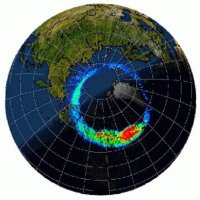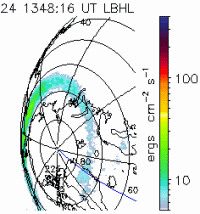Cluster links magnetic substorms and Earthward directed high-speed flows
24 August 2006
High-speed flows of plasma, known as bursty bulk flows (BBF), are propagating in the inner central plasma sheet of the Earth's magnetotail at velocities higher than 300 kms-1. They are the carriers of decisive amounts of mass, energy and magnetic flux towards the Earth but their link to magnetic substorms was never absolutely established. Based on data recorded during July-October 2001 and 2002 by three spacecraft of the Cluster mission, a statistical study reveals, for the first time, that more than 95% of magnetic substorms observed in this time period are accompanied by BBF. It also shows that BBF last longer than previously estimated and may account for up to 20% of the energy transport of a substorm. Published 7 April 2006 in the Journal of Geophysical Research, these results enhance previous studies based on single spacecraft measurements.
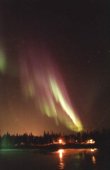 |
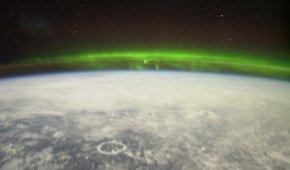 |
|
Image 1. Northern lights observed in Canada (Credit: Canadian Space agency/Agence Spatiale Canadienne) | |
Colourful auroras due to magnetic substorms are regularly observed in auroral regions from the ground (Image 1), the International Space Station (Image 2) or by satellites (Image 3 and animation 1). These auroras are caused mostly by energetic electrons spiralling down the Earth's magnetic field lines and colliding with atmospheric atoms at ~100 km altitude range. Where do these electrons come from? The magnetotail; a region of space located on the nightside of Earth where the solar wind stretches out terrestrial magnetic field lines into a long tail. In its centre, a denser region known as the plasmasheet is present (Image 4). A substorm represents violent changes of the plasmasheet that energize and hurl earthward electrons and ions. Substorms last up to a couple of hours. Apart from the beautiful light show, substorms also excite a large portion of the Earth's ionosphere, perturbing the reception of GPS signals and communications between Earth and orbiting satellites.
A key issue about substorms is to determine the primary earthward transport mechanism of mass, energy and magnetic flux. One possible candidate is the phenomenon of Bursty Bulk Flow (BBF). BBFs are high-speed flows (>300 kms-1) occurring in the inner central plasmasheet. Discovered in the late 80's [Baumjohann et al., 1988, 1989, 1990], such flows are spatially confined and temporally limited, typically lasting 10 minutes (see Spatial scale of high-speed flows in the magnetotail). Despite their short duration, BBF are the carriers of decisive amounts of mass, energy and magnetic flux. In other words, BBF can stir plasma very efficiently from the plasmasheet towards the Earth.
[Angelopoulos et al., 1992, 1994] showed that BBFs mainly occur during active magnetospheric periods and are in particular related to phases of substorms. However, follow-up studies concluded that BBF is not the main transport mechanism during a substorm, in particular due to their median observed duration of 10 minutes. A recent statistical study led by Dr Jinbin Cao, Key laboratory of Space Weather, Beijing, China, challenged this result. Using observations of central plasma sheet collected by three satellites of the ESA/NASA Cluster mission during July - October of 2001 and 2002, Dr Cao and colleagues found 67 substorms and 209 BBFs. First, they used the observations of only one spacecraft, Cluster 1 (C1). In this case, 22% of the substorms are not accompanied by BBFs. However, the combined observations of C1, C3 and C4 show that in fact only 4.5% of substorms are not accompanied by BBFs.
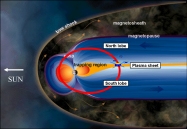 |
|
Image 4: Sketch of the Earth's magnetosphere |
"For the first time, it seems possible that all substorms are accompanied by BBFs", wrote Dr. Cao and colleagues in the Journal of Geophysical Research on 7 April 2006. Dr Cao is Co-Investigator of the Cluster Ion Spectrometer (CIS) experiment.
Another key result of this statistical study holds in the average BBF duration found. Past studies estimated a BBF to typically last 10 minutes. Again a discrepancy was found between an analysis based on single spacecraft measurements and multiple spacecraft data. Single satellite observations confirmed past results (604s, ~10 minutes) while multi-satellites observations reveal an average duration almost twice longer: 1105s, or 18 minutes 25 seconds.
"Previous studies show that the BBFs are responsible for 10% of the energy transport of a substorm. According to our results, BBFs are able to offer 20% of the transport under the same conditions", wrote Cao.
"These new results by the Cluster mission clearly show that multi-point observations is key to understand the magnetic substorm phenomenon. We look forward to collaborating with the upcoming NASA THEMIS mission, a five spacecraft mission dedicated to the study of substorms and its triggering mechanism, scheduled to be launched in the fall 2006", says Philippe Escoubet, Cluster and Double Star project scientist of the European Space Agency.
J. B. Cao, Y. D. Ma, G. Parks, H. Rème, I. Dandouras, R. Nakamura, T. L. Zhang, Q. Zong, E. Lucek, C. M. Carr, Z. X. Liu, and G. C. Zhou, Joint observations by Cluster satellites of bursty bulk flows in the magnetotail, J. Geophys. Res., 111, A04206, doi:10.1029/2005JA011322, 2006.
Related Peer Reviewed Articles
Angelopoulos, V., et al. (1992), Bursty bulk flows in the inner central plasma sheet, J. Geophys. Res., 97, 4027Angelopoulos, V., et al. (1994), Statistical characteristics of bursty bulk flow events, J. Geophys. Res., 99, 21, 257
Baumjohann, W., et al. (1988), Average ion moments in the plasma sheet boundary layer, J. Geophys. Res., 93, 11, 507
Baumjohann, W., G. Paschmann, and C. A. Cattell (1989), Average plasma properties in the central plasma sheet, J. Geophys. Res., 94, 6597
Baumjohann, W., G. Paschmann, and H. Lühr (1990), Characteristics of the high-speed flows in the plasma sheet, J. Geophys. Res., 95, 3801
Contacts
Jinbin Cao, Key laboratory of Space Weather, CSSAR/CAS, 100080 Beijing, ChinaE-mail: jbcao
 center.cssar.ac.cn
center.cssar.ac.cnPhone: +86-10-62582644
Yuduan Ma, Key laboratory of Space Weather, CSSAR/CAS, 100080 Beijing, China
E-mail: myd3369 163.com
163.com
Phone: +86-10-58732545
Web story author and co-editor
Arnaud Masson, SCI-SO division, RSSD, ESA, The Netherlands
E-mail: Arnaud.Masson esa.int
esa.int
Phone: +31-71-565-5634
Web story editor
Philippe Escoubet, SCI-SM division RSSD, ESA, The Netherlands
E-mail: Philippe.Escoubet esa.int
esa.int
Phone: +31-71-565-4564

